Setup: Device EtherCAT
|
Table of contents |
|---|
|
• Notes on the EtherCAT device |
A downlink port of the CU2508 is set up as an EtherCAT device. The correct setup of the CU2508 device is assumed.
Notes on the EtherCAT device
- The CU2508 downlink port appears as the first regular EtherCAT slave. It can optionally represent the Distributed Clocks reference clock in this EtherCAT system. The port has no controllable I/O.
- All CU2508 downlink ports are synchronized with each other.
- A second CU2508 port can be used as a ring closure for EtherCAT cable redundancy. The primary EtherCAT connection must then be connected to an odd CU2508 port (X1, X3 etc.) and the secondary redundancy adapter to the following even CU2508 port (refer to the corresponding chapter Device EtherCAT with cable redundancy).
- The CU2508 sends EtherCAT frames in pass-through mode without time stamps.
Setting up an EtherCAT device
In EtherCAT operation the CU2508 downlink port used is not transparent, but appears as a Distributed Clocks-capable EtherCAT slave in the configuration. As a result it can appear as a reference clock. However, the EtherCAT slave is otherwise not parameterizable or addressable.
As applies to every EtherCAT device, the current ESI xml files should be present in the TwinCAT system for the CU2508 also. This applies both to the offline creation of the configuration and to scanning in online operation. The files (in particular “Beckhoff CUxxxx.xml”) can be procured from the download area on the Beckhoff web page. They are to be saved under "… \ TwinCAT\Io\EtherCAT\".
 | Updating the ESI XML files If the following information window should appear in online mode when scanning the devices on the CU2508: (see Fig. Information window "Online description") then an update for above mentioned file is necessary: |
 Fig.33: Information window "Online description"
Fig.33: Information window "Online description" | Creation of the configuration The simple option to create the configuration by scanning the real hardware is only possible if an EtherCAT device is manually connected to a CU2508 port in the configuration. |
Configuration settings under TwinCAT 2.11R2
Creating an EtherCAT device
An EtherCAT device can be added by right-clicking on I/O Device - > Append Device.
 Fig.34: Creating an EtherCAT device
Fig.34: Creating an EtherCAT device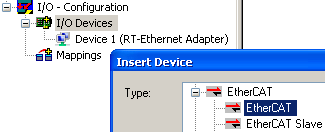 Fig.35: Selection of the "EtherCAT" device
Fig.35: Selection of the "EtherCAT" deviceThe desired downlink port of the CU2508 can now be selected.
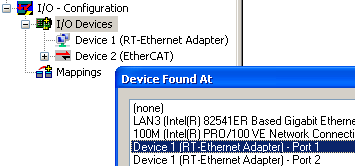 Fig.36: Selection of the CU2508 port
Fig.36: Selection of the CU2508 portThe device "Device 2 (EtherCAT)" is now connected, according to the adapter reference, not to a physical Ethernet port of the controller, but to a logical adapter reference of the CU2508. This assignment can also be changed later. The freerun cycle time in the TwinCAT ConfigMode is shown here for the adapter.
 Fig.37: Adapter setting for the EtherCAT device
Fig.37: Adapter setting for the EtherCAT device | Creation of the configuration Scanning of the EtherCAT configuration is also possible from this state onwards. |
Creating a CU2508 box
The CU2508 downlink port appears as an EtherCAT slave and can be scanned or created manually.
 Fig.38: Appending a CU2508 EtherCAT slave
Fig.38: Appending a CU2508 EtherCAT slaveIf creating manually, the “CU2508 Ethernet port” CU2508-0000 must be selected. The check box "ExtendedInformation" displays the revision numbers, in this case -0000 (fig. Selection of “CU2508 Ethernet Port”).
If "CU2508" is entered in the Search mask, the overview is reduces to the sought device.

Fig. 7: Selection of “CU2508 Ethernet Port”
Further EtherCAT slaves can now be appended to the CU2508 Box.
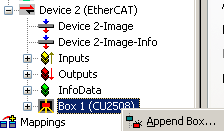 Fig.39: Appending further EtherCAT slaves
Fig.39: Appending further EtherCAT slavesDistributed Clocks settings
All CU2508 downlink ports are synchronized with each other and can appear as ReferenceClock in the respective EtherCAT strand. In the default setting, however, the CU2508 port is not marked as Distributed-Clocks-capable, hence under TwinCAT the next subsequent Distributed-Clocks-capable slave is selected as the ReferenceClock. In each case the CU2508 port is the 1st slave in the respective strand.
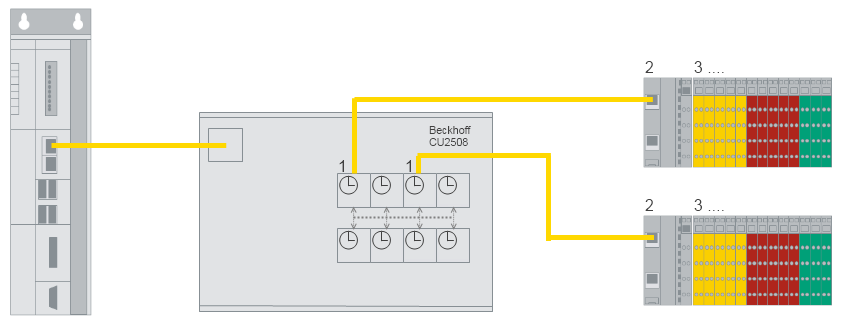 Fig.40: EtherCAT Distributed Clocks reference
Fig.40: EtherCAT Distributed Clocks referenceIf the CU2508 port is to be used as the ReferenceClock in a system, the setting "Use as potential ReferenceClock" must be changed; see fig. CU2508 slave - Distributed Clocks setting.
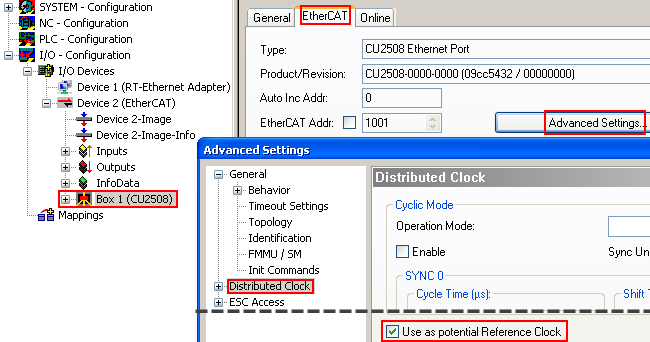 Fig.41: CU2508 slave - Distributed Clocks setting
Fig.41: CU2508 slave - Distributed Clocks setting | Synchronized EtherCAT systems If several EtherCAT systems are to be operated on CU2508 ports synchronized with the same time base, the flag "Use as potential Reference Clock" must be set in the appropriate "CU2508 box". External synchronization to another time base is then not possible. |
The internal clock in the CU2508 works independently and is only managed by the CU2508 driver.
EoE settings (Ethernet over EtherCAT)
If devices with EoE support are used in a lower-level EtherCAT system, this affects the settings of the EoE switch in the CU2508 if this is configured for EoE transport. Refer to the Notes pages on TCP/IP traffic.
If such devices are present in the EtherCAT system,
- the Virtual Ethernet Switch must be enabled (“Enable”)
- “Connect to TCP/IP Stack” can be activated
- the numbers "Max Frames" and "Max MAC IDs" can be increased if throughput problems are determined
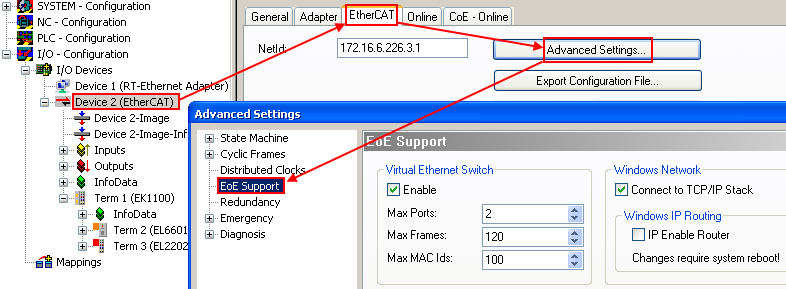 Fig.42: EtherCat device EoE settings
Fig.42: EtherCat device EoE settingsIf several EtherCAT system EoE devices are used, this increases the settings of the CU2508 EoE switch.
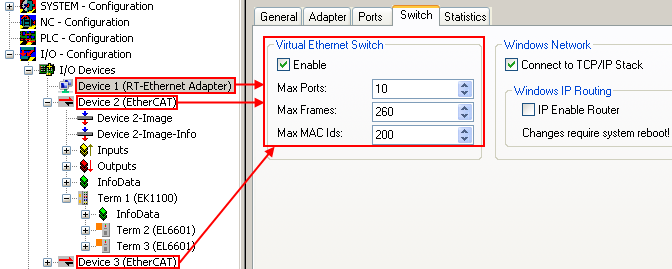 Fig.43: CU2508 EoE settings
Fig.43: CU2508 EoE settings